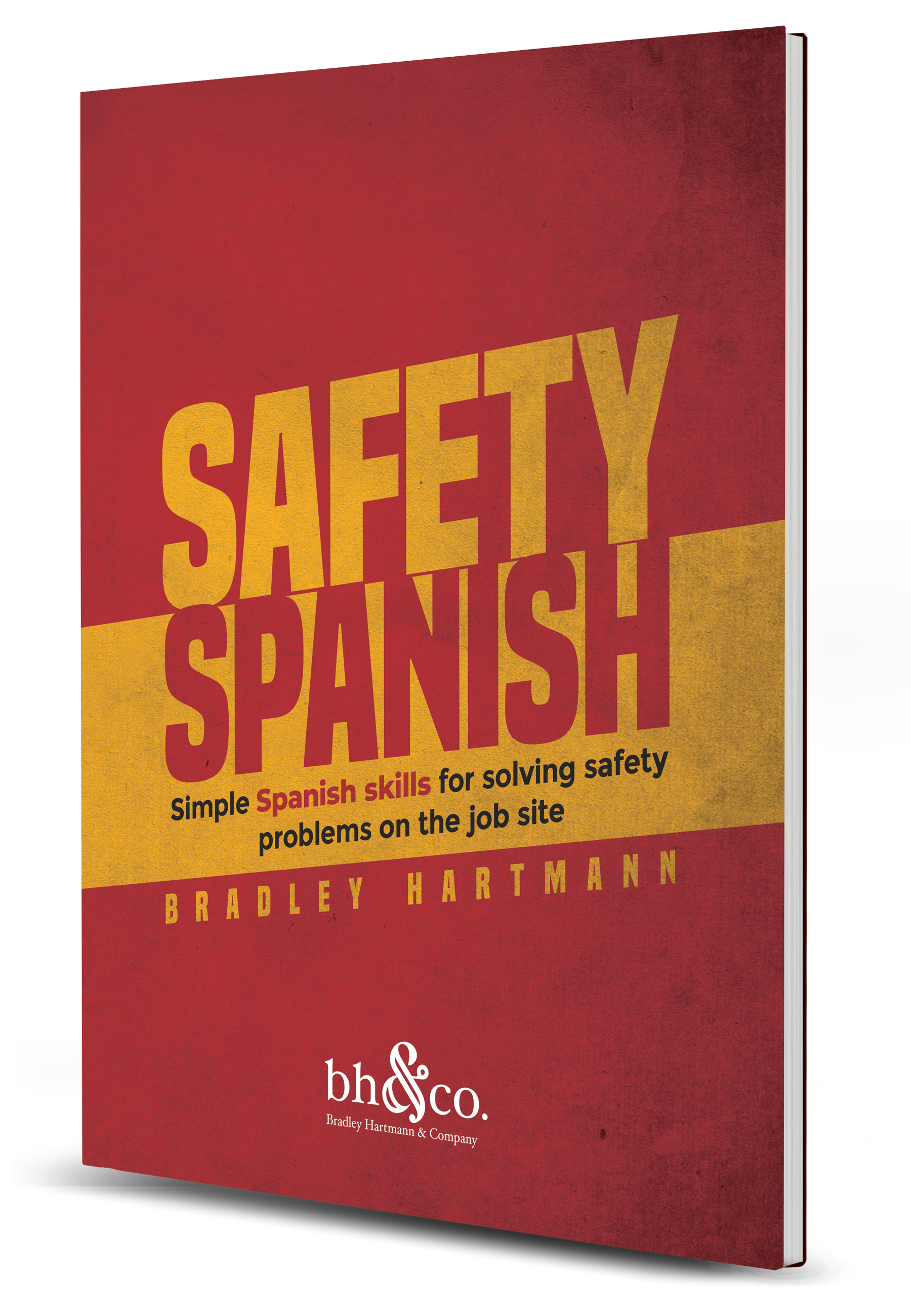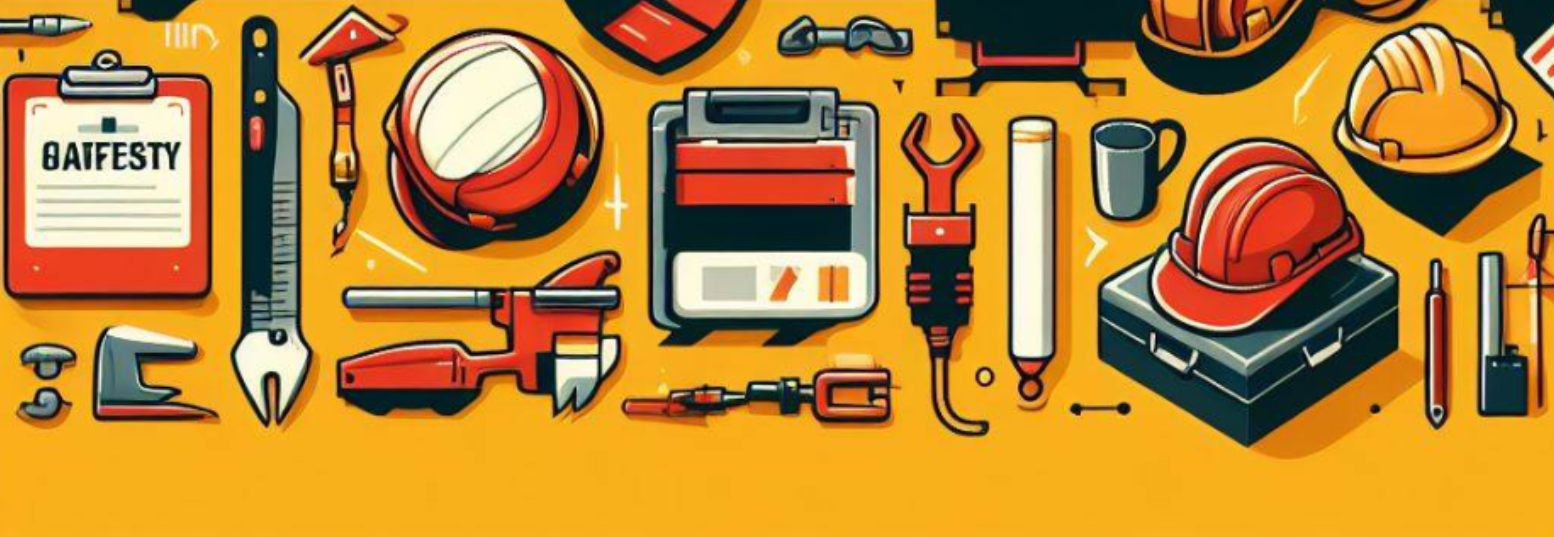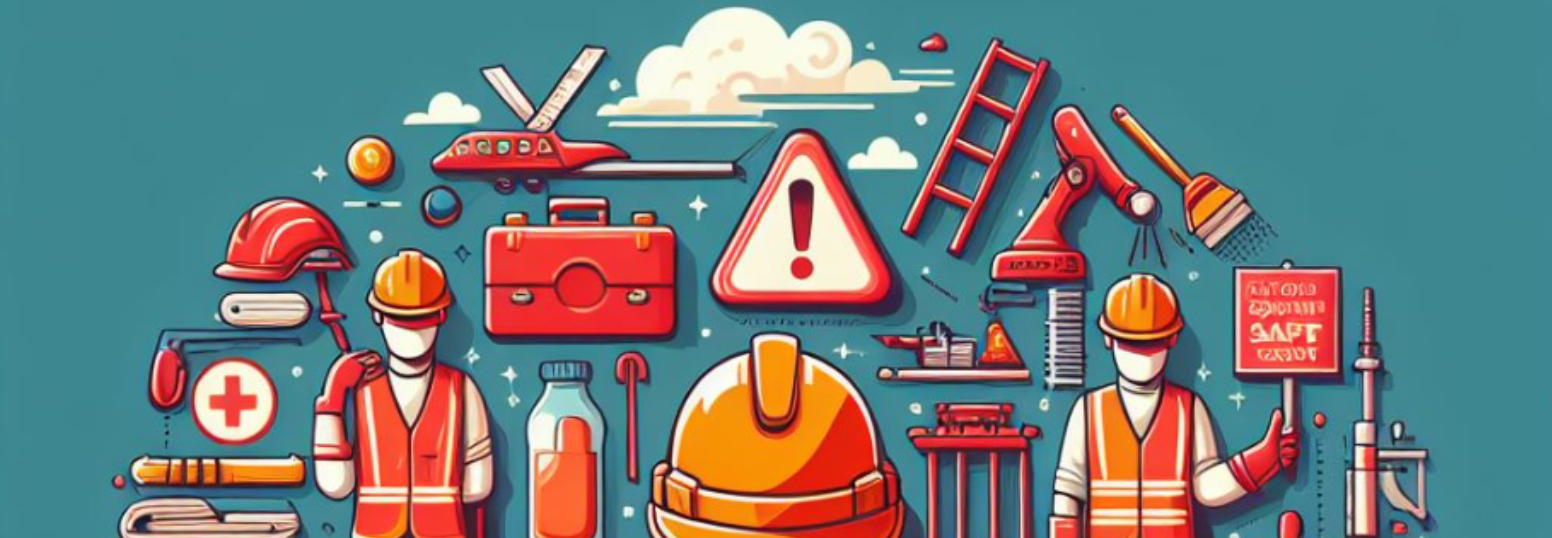Guide to Key Spanish Words for Jobsite Safety
How to communicate safety with a Spanish-speaking crew.
Welcome to our comprehensive guide aimed at equipping English-speaking construction workers with essential safety terminology for the jobsite, en español. In the fast-paced environment of construction, effective communication is paramount, especially when it comes to ensuring the safety and well-being of all workers. This guide has been meticulously crafted to provide you with the vocabulary and phrases necessary to navigate jobsite safety discussions confidently and effectively in Spanish, fostering a safer and more inclusive work environment for all. Whether you're just starting out in the industry or looking to brush up on your language skills, this resource will serve as a valuable tool in your quest for workplace safety excellence. ¡Empecemos! (Let's get started!)
Bradley Hartmann & Company has specialized in developing memorable and brief guides for construction professionals to learn a 2nd language in a way that is directly applicable to their daily work. See our 6-week Construction Spanish class to go deeper with our professional training program, or check out any of Bradley’s books for more help learning Construction Spanish.
Learn more Spanish terms for jobsite safety crews in our construction Spanish glossary.
6-Week Spanish Course Books
Books are only available in the respective 6-Week Spanish course.
Key areas of focus to learn construction safety terms in Spanish
1. Construction Safety Terms
At Hartmann & Co., our passion is construction. This is the only sandbox we play in. Our narrow focus ensures the content in this book represents what you need to know on the job. But don't just take our word for it. We've partnered with leading construction firms and subcontractors from across the country. Each shared their perspectives on what they needed to know.
2. High-Frequency Terms/Phrases
You may be aware of the Pareto Principle, also known as the 80/20 Rule. It states that 80 percent of the effects come from 20 percent of the causes. We've applied this principle to Safety Spanish to leverage the most commonly used terms, phrases, and conversations on the job.
3. Relevant Spanish Twins™
There are thousands of terms that are identical or nearly the same in both English and Spanish. For a more in depth breakdown of Spanish Twin examples, see our books and courses. This guide will focus more on points one and two above.
Core Concepts from Chapter 1 of Safety Spanish
Spanish Rule #1: Always start with donkeys
Children in Spanish-speaking countries often learn phonetics with the phrase, Mi burro sabe más que tú. The phrase helps them practice the various vowel sounds. Translated it means, “My donkey knows more than you”. While I do not recommend you say this on the job site to workers you do not know (you may get punched in the face), I do recommend you practice it to gain confidence in pronouncing the vowels en español.
| Spanish | Pronunciation | English |
|---|---|---|
| Mi | (MEE) | My |
| burro | (BOOH-rroh) | donkey |
| sabe | (SAH-bay) | knows |
| más | (MAHS) | more |
| que | (KAY) | than |
| tú | (TOOH) | You |
After donkeys, the first thing to know about the Spanish language is this: Spanish is a phonetic language.
This means the letters in the Spanish alphabet always sound the same. Always.
A second nice feature of the Spanish language is the use of the accent mark. It's a visual hint indicating where to place the emphasis when pronouncing the word. The default emphasis in Spanish is placed on the next-to-last syllable.
This guide is built from excerpts from Bradley Hartman’s book, Safety Spanish. If you are looking to learn more be sure to check out our Safety Spanish training program.
Core Terms You Just Gotta Know
Whether you're engaging in safety protocols, giving instructions, or simply seeking to connect with Spanish-speaking colleagues, mastering these core terms will greatly enhance your ability to communicate confidently and accurately.
Each term in this chart is accompanied by its pronunciation, meaning, and a mnemonic device to aid in retention and recall. By familiarizing yourself with these fundamental expressions, you'll not only broaden your vocabulary but also strengthen your ability to engage meaningfully with Spanish speakers.
| TERM | PRONUNCIATION | MEANING | HOW TO REMEMBER |
|---|---|---|---|
| la seguridad | (say-gooh-ree-DAHD) | safety | Think security. |
| seguro/a | (say-GOOH-roh) | safe | Again, think of secure. |
| importante | (eem-pohr-TAHN-tay) | important | Spanish TwinTM! You'll use this daily. |
| ¡Cuidado! | (kwee-DAH-doh) | Be careful! | A hack is not needed. |
| ¡Mira! | (MEE-rah) | Look! | Just look in the mira. |
| ¿Cómo se dice? | (KOH-moh say DEE-say) | How d'you say? | Power Phrase. Use daily. |
| Despacio. | (day-SPAH-see-oh) | Slowly | Bieber: despacito. |
| por favor | (pohr fah-VOHR) | please | Please, for a favor. |
| Repítelo. | (ray-PEE-tay-loh) | Repeat it. | Twin, use with por favor. |
Core PPE Terms:
Whether you're a safety manager, a supervisor, or a worker, having access to clear and precise translations of PPE terminology ensures that everyone understands the importance of safety measures and can effectively communicate about the necessary equipment.
We've curated this resource with a commitment to accuracy and clarity, drawing upon industry standards and linguistic expertise to provide reliable translations for various PPE items and terms. With this guide, you can confidently navigate safety protocols and procedures, fostering a safer and more inclusive work environment for all.
Please refer to the table below for accurate translations of essential job site PPE equipment terminology from English to Spanish.
| TERM | PRONUNCIATION | MEANING | HOW TO REMEMBER |
|---|---|---|---|
| el casco | (KAH-skoh) | hardhat | Wear your casco to Costco. |
| la cabeza | (kah-BAY-sah) | head | Watch your cabeza getting into the cab. |
| el chaleco | (chah-LAY-koh) | safety vest | Cha-lay Brown with his chaleco. |
| el cuerpo | (KWAYR-poh) | body | Corpus in Latin means body. |
| los guantes | (GWAHN-tays) | gloves | No guantes en Guam. |
| las manos | (MAH-nohs) | hands | hand-to-hand combat is... |
| la espalda | (ay-SPAHL-dah) | back | |
| el arnés | (ahr-NAYS) | harness | Drop the H and an s. |
| los lentes | (LAYN-tays) | safety glasses | Lenses with a T for an S. |
| la máscara | (MAHS-kah-rah) | dust mask | Apply your mascara wearing una máscara. |
| el respirador | (ray-spee-rah-DOHR) | respirator | One letter away from identical spanish twins |
| las botas | (BOH-tahs) | boots | Oye. Puss en botas, güey. |
Ear Protection
Exposure to excessive noise levels can lead to hearing loss and other serious health issues. Proper ear protection not only mitigates these risks but also ensures compliance with safety regulations and standards. Whether you're working in construction, manufacturing, or any other industry with high noise levels, understanding and utilizing appropriate ear protection is essential.
In this section, you'll find detailed descriptions of various types of ear protection, including earplugs and earmuffs, along with guidance on their proper use and maintenance. Additionally, we've provided translations of key terms related to ear protection in both English and Spanish, facilitating clear communication and comprehension among diverse work teams.
| TERM | PRONUNCIATION | MEANING | HOW TO REMEMBER |
|---|---|---|---|
| los tapones | (tah-POH-nays) | Earplugs | Just TAP 'em ON! |
| la espuma | (ay-SPOOH-mah) | Foam | Foam: los tapones de espuma. |
| el ruido | (rooh-EE-doh) | Noise | All that ruido will ruin your hearing! |
| oír | (oh-EER) | To hear | Oir and hear rhyme. |
| los oídos | (oh-EE-dohs) | Inner ears | you oir with your oídos. |
| las orejas | (oh-RAY-hahs) | Outer ear | Ol' Ray has the best orejas ever. |
| proteger | (proh-tay-HAYR) | To protect | a near Spanish TwinTM |
| oreja | (oh-RAY-hah) | Outer ear |
Hand Safety
By prioritizing hand safety and adhering to best practices outlined in this section, you'll not only protect yourself from harm but also contribute to a culture of safety and accountability in your workplace.
| TERM | PRONUNCIATION | MEANING | HOW TO REMEMBER |
|---|---|---|---|
| los guantes | (GWAHN-tays) | Gloves | No necesitas guantes en Guam. |
| los dedos | (DAY-dohs) | Fingers | think dedos as digits. |
| el nudillo | (nooh-DEE-yoh) | Knuckle | Ever try a Nudillo Sandwich con Nutella? You should. It's muy rico. |
| la mano | (MAH-noh) | Hand | Note: it's la mano, not el mano. |
| el pulgar | (pool-GAHR) | Thumb | Gimme the "pulgar up" sign if you want to go to the pool! |
| la muñeca | (moon-YAY-kah) | Wrist, doll | Esa muñeca has a pair of muñecas. |
| la uña | (OOHN-yah) | Finger nail | Sí, una uña is a fingernail. |
| la palma | (PAHL-mah) | Palm | Just add an A, Spanish TwinTM. |
The Vocabulary of Falls
Falls on the job occur all too often and are often very preventable. We'll now dig into el vocabulario around falls.
| TERM | PRONUNCIATION | MEANING | HOW TO REMEMBER |
|---|---|---|---|
| la escalera | (ay-skah-LAY-rah) | Ladder | Escalate up la escalera. |
| las escaleras | (ay-skah-LAY-rahs) | Stairs | Also escalate up las escaleras. |
| peligroso | (pay-lee-GROH-soh) | Dangerous | It's oh-so peligroso. |
| caer | (kah-YAYR) | To fall | Caer = KA-boom. |
| la caída | (kah-EE-dah) | Fall | Derivative of caer. |
| el otoño | (oh-TOHN-yoh) | Fall, Autumn | don't mix this up, por favor. |
| el derrame | (day-RRAH-may) | Spill | Un derrame in the day room. |
| el resbalón | (ray-sbah-LOHN) | Slip | Rest on a balón (ball) and you'll slip. |
| resbaloso | (ray-sbah-LOH-soh) | Slippery | See above. |
Weather
The weather-el clima-can be more than a worthy adversary to the best laid safety plans. Below are the most common weather terms that can cause slips and caídas.
| TERM | PRONUNCIATION | MEANING | HOW TO REMEMBER |
|---|---|---|---|
| el calor | (kah-LOHR) | Heat | El calor es caliente. |
| el viento | (bee-AYN-toh) | Wind | Viento es bien. Wind is good. |
| ventoso | (bayn-TOH-soh) | Windy | See its cousin above. |
| la lluvia | (YOOH-bee-ah) | Rain | You be a wet one if you stand en la lluvia. |
| el hielo | (YAY-loh) | Ice | ¡Hielo! Iceman speaking... |
| la tormenta | (tohr-MAYN-tah) | Storm | Una tormenta can torment you. |
| el frío | (FREE-oh) | Cold | It's frío... and freezing! |
| la nieve | (nee-AY-bay) | Snow | My knees are covered in nieve. |
| el clima | (KLEE-mah) | Climate, weather | Just drop the -te. |
| el lodo | (LOH-doh) | Mud | Drop your wallet in the lodo and you'll be low on dough. |
Caught-In Between & Struck By
Now it's time to address the next group of common negative outcomes that can result from a lack of safety awareness: situaciones where workers are caught in- between two things (atrapado-you see trapped in there) or struck by something (golpeado). Let's start by reviewing things on the job that can cause cuts, slices, and gashes.
| TERM | MEANING | HOW TO REMEMBER |
|---|---|---|
| la varilla | Rebar | The best-tasting rebar in Italy. |
| la tapa | Cap | La tapa goes on top-a la varilla. |
| agudo/a | Sharp | That a-gouda cheese is aguda! |
| la herida | Wound | Ay, Rita! Come look at this herida! |
| el corte | A cut | Cortar = to cut. |
| el clavo | Nail | Clobber that clavo. |
| la sangre | Blood | That's not sangría, it's sangre. |
| el tornillo | Screw | Turn it, yo... in Tornillo, TX. (Yep, it's a place.) |
| la grapa | Staple | You gotta grapple con las grapas. |
Electrical Safety Terms in Spanish
And now, mis compañeros, we come to the fourth of the Focus Four Hazards- electrical. Vamos a comenzar el tópico de la electricidad con algunas palabras que comienzan con la letra C. ¿OK? Vámonos. (How'd you do there with the instructions in Spanish? Good enough, right? Trust yourself!)
| TERM | MEANING | HOW TO REMEMBER |
|---|---|---|
| caliente | Hot | Yes, it gets rather caliente in Caliente, NV. |
| el candado | Lock | the candidate was a candado for office. |
| el panel | Panel | identical Spanish TwinTM |
| control | Control | ibid. ¿Dónde está el panel de control? |
| el choque | Shock | think of the CH as SH and it's a visual Spanish TwinTM |
| el cable | Cable | Cuidado. Hay un cable aquí. |
| el enchufe | Outlet | Chewbacca needs un enchufe nearby for his bowcaster blaster. Can't be outta juice. |
Tools: From Safety Spanish Section 5.5
The word for tool in Spanish-la herramienta-is a mouthful, admittedly. Rather than complain about the pronunciation en español, the team at Hartmann & Co. is on to the English language-herrament. It shall be a synonym for tool and will then be a journey to introduce a longer, more cumbersome, and decidedly more pretentious term Spanish Twin. (Is this weird? No. It's not. Let's keep moving.)
| Spanish | Pronunciation | English Translation |
|---|---|---|
| la sierra | (see-AY-rrah) | Saw |
| el serrucho | (say-RROOH-choh) | Handsaw |
| el marro | (MAH-rroh) | Sledge |
| el martillo | (mahr-TEE-yoh) | Hammer |
| la pala | (PAH-lah) | Shovel |
| la navaja | (nah-VAH-hah) | Knife |
| la escoba | (ay-SKOH-bah) | Broom |
| la bomba | (BOHM-bah) | Pump |
| el taladro | (tah-LAH-droh) | Drill |
We encourage you to continue learning and staying updated on safety standards and regulations relevant to your industry via our spanish training programs and courses. Additionally, don't hesitate to engage with safety professionals and colleagues to seek guidance and support when needed. Together, we can create safer and healthier work environments for everyone.
Thank you for investing your time and attention in prioritizing safety. Here's to a future where every workplace is free from preventable accidents and injuries.









